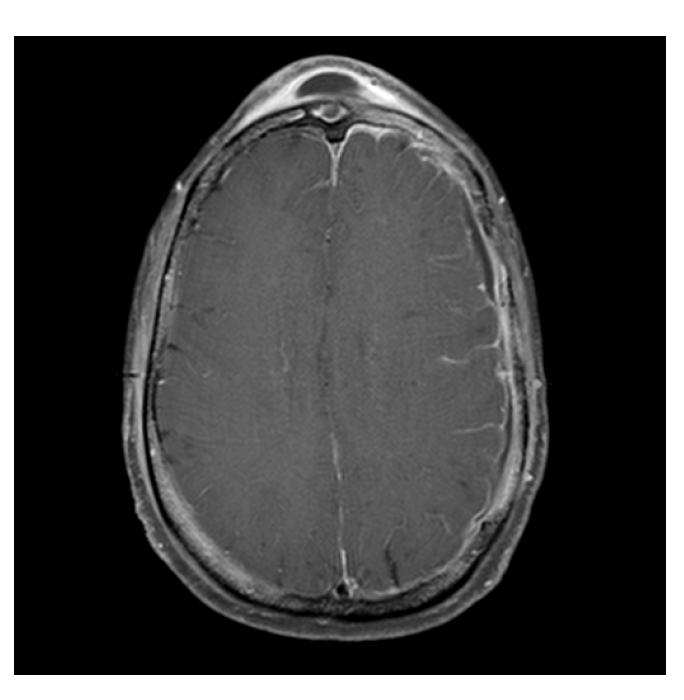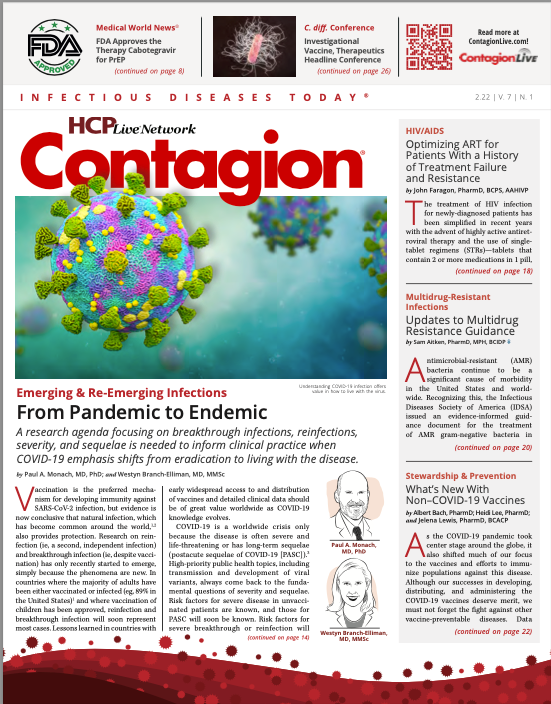Final Diagnosis: Pott Puffy Tumor With Subdural Empyema
A rare case of Pott puffy tumor occurs in an atypical patient with no risk factors, likely due to untreated sinus infection.
FINAL DIAGNOSIS
Pott puffy tumor with subdural empyema
HISTORY OF PRESENT ILLNESS
An African American female, age 64 years, presented to the emergency department with a chief complaint of headache that had been increasing in intensity for 4 days. The headache was mainly located across the frontal region of the head and worsened with movement. Pain was also present in the neck whenever she sat up. In the emergency department, the patient was febrile with a temperature of 100.9 °F, hypertensive to 191/111 mm Hg, and found to have elevated liver enzymes. Initial work-up with a CT angiogram of the head and neck was negative for acute findings but showed chronic maxillary, ethmoid, and frontal sinus disease. Ultrasound of the abdomen showed mild dilation of the common bile duct. The patient was admitted and treated for hypertensive urgency thought to be the cause of her headaches, and gastroenterology was consulted for hepatobiliary workup. Antibiotics were held.
MEDICAL HISTORY
The patient’s medical history included hypertension, non-Hodgkin lymphoma with last chemotherapy treatment 4 years prior to presentation, and a remote history of pulmonary emboli treated with 6 months of anticoagulation. Surgical history included cholecystectomy and tubal ligation.
KEY MEDICATIONS
The patient was taking aspirin, garlic capsules, potassium chloride, magnesium citrate, and coenzyme Q10.
EPIDEMIOLOGICAL HISTORY
The patient had no recent sick contacts, had not traveled recently, and had not noticed any tick bites or rashes. She was widowed and retired. She had no pets at home and never smoked or drank alcohol. Her mother died from cerebral hemorrhage.
T1-weighted postcontrast axial view MRI demonstrating a frontal subperiosteal abscess, subdural empyema with leptomeningeal enhancement, and mild enhancement within the marrow of the calvarium.

PHYSICAL EXAMINATION
Upon admission to the hospital, the patient was found to have a temperature of 100.9 °F (38.3 °C), pulse of 108 beats/ min, blood pressure of 192/111 mm Hg, respiratory rate of 20 breaths/min, and oxygen saturation of 97% on room air. She was in no acute distress and an examination of the chest and abdomen were unremarkable. Neurological examination showed normal results.
On day 3 of hospitalization, the patient was found to have a maximum temperature of 102.7 °F, pulse of 76 beats/min, and blood pressure of 172/85 mm Hg. She had chattering teeth and was warm to the touch. There was a fluctuant, soft, fluid-filled mass in the center of her forehead, and she exhibited very mild nuchal rigidity. The remainder of the examination was unremarkable.
STUDIES
Initial laboratory studies demonstrated a white blood cell count of 10,900 cells/ μL (4,000-11,000 cells/μL), creatinine of 0.79 mg/dL (0.70-1.40 mg/dL), aspartate aminotransferase of 246 U/L (7-35 U/L), alanine aminotransferase of 280 U/L (< 30 U/L), and alkaline phosphatase of 177 U/L (25-120 U/L). Blood cultures showed no growth.
CT angiogram of the head and neck with contrast showed chronic right maxillary, ethmoid, and frontal sinus disease. Abdominal ultrasonography showed a mildly dilated common bile duct and normal appearance of the liver. MRI of the abdomen was within normal limits without choledocholithiasis. CT of the chest with intravenous contrast showed no pulmonary embolism and no change in the previously noted mediastinal and hilar lymphadenopathy.
CLINICAL COURSE
On day 3 of hospitalization, the patient began to develop higher fever with a maximum temperature of 102.7 °F. Infectious diseases was consulted at this time for fevers of unclear etiology. During the initial consultation, physical examination revealed a soft, nontender, fluid-filled protrusion on the patient’s forehead. Vancomycin, ceftriaxone, and ampicillin were started for empiric meningitis coverage. An MRI of the head was ordered stat, and the neurosurgery and otolaryngology departments were consulted at the request of infectious disease staff. MRI of the brain with and without contrast revealed right maxillary frontal sinusitis with an associated frontal subperiosteal abscess, left subdural empyema with leptomeningeal enhancement and associated mass effect, as well as calvarium osteitis. This confirmed the diagnosis of Pott puffy tumor with subdural empyema. Metronidazole was added for anaerobic coverage. Soon after the MRI results were obtained, the patient began to clinically decline, becoming increasingly lethargic and confused overnight. The patient was transferred to the neurosurgery intensive care unit.
DIAGNOSTIC PROCEDURES AND RESULTS
Otolaryngology staff performed a nasal endoscopy, which showed bilateral edema of the nasal mucosa with no pus. On day 4 of admission, patient was taken to the operating room (OR) by neurosurgery and otolaryngology staff. Patient underwent a left craniectomy and evacuation of subdural empyema with a Jackson-Pratt drain left in place, along with concomitant septoplasty and right maxillary antrostomy with frontal sinus drain. OR cultures taken from the collection grew viridans group Streptococcus intermedius and methicillin-susceptible Staphylococcus epidermidis. Acid-fast bacilli cultures, fungus cultures, and cytology gave negative results.
TREATMENT AND FOLLOW-UP
Following surgery, the patient’s clinical and neurological status improved within 48 hours. Drains were removed after 2 days. She was discharged on postoperative day 7 with high-dose ceftriaxone and metronidazole for 8 weeks. During follow-up in clinic, patient had complete resolution of all symptoms and returned to neurologic baseline. A brain MRI 4 weeks post surgery showed resolution of Pott puffy tumor and a diminished subdural empyema. A follow-up MRI 3 months post surgery showed complete resolution of the empyema.
DISCUSSION
Pott puffy tumor is a rare clinical entity first described in the 18th century by Sir Percivall Pott, an English surgeon, as a subperiosteal abscess of the frontal bone with underlying osteomyelitis. Infection from the frontal sinus may spread either by direct extension into the underlying bone, causing osteomyelitis, or through hematogenous spread with infectious thrombophlebitis.1 The diploic veins between the inner and outer layers of the cortical bone are valveless and thin walled, which facilitates the hematogenous spread of the sinus infection. When the infection extends posteriorly, this can cause meningitis, epidural abscess, subdural empyema, and septic dural or cavernous sinus thrombosis.1,2 Pott puffy tumor can also result from head trauma and, less commonly, craniotomy, dental infection, cocaine abuse, and insect bites. Risk factors for developing Pott puffy tumor include diabetes and immunosuppression; male adolescents tend to be most affected.1,2
On physical examination, Pott puffy tumor is classically described as a fluctuant, tender, erythematous, soft swelling of the forehead. It usually presents with associated symptoms of headaches, fevers, rhinorrhea, and nasal congestion.1-3 Often the first study to confirm the diagnosis is a CT of the head with contrast, which will show frontal sinusitis along with a subperiosteal effusion and possible intracranial extension.2 An MRI of the head is the preferred imaging tool for diagnosis because it shows greater detail of intracranial involvement. MRI is also the preferred imaging technique following recovery.2,3
Treatment of Pott puffy tumor includes a combination of systemic antibiotics and surgical debridement. It is usually considered a surgical emergency. Surgery can either be open with a craniotomy to remove the infected bone and drain abscesses, or minimally invasive with endoscopic sinusotomy.4 The most common organisms involved include nonenterococcal streptococci, staphylococci species, and oral anaerobes.5 Empiric antibiotics should include broad-spectrum coverage for gram-positive cocci and anaerobes and have good penetration of the blood–brain barrier. A typical regimen would include vancomycin, a third-generation cephalosporin, and metronidazole. Antibiotic therapy can then be targeted to the culture results. Patients will typically need 4 to 8 weeks of intravenous antibiotics.2,5 Successful recovery from Pott puffy tumor is dependent on rapid diagnosis and initiation of treatment. The prognosis is worse if there is greater intracranial involvement or if the infection is left untreated for an extended period.6
Our rare case of Pott puffy tumor occurred in an adult female, not a male adolescent, with no known risk factors. Etiology was most likely from an untreated sinus infection. The case is moreover unique in that her presentation seemingly developed and progressed during her admission. There was no abscess noted on the admission CT angiogram of the head or the initial physical examination by the hospitalist. This case emphasizes the significance of the daily physical examination in contributing to a time-sensitive critical diagnosis. It is important for physicians to be aware of this rare clinical examination finding and to know what the next steps are to employ once it is discovered.
References
1. Suwan PT, Mogal S, Chaudhary S. Pott’s puffy tumor: an uncommon clinical entity. Case Rep Pediatr. 2012;2012:386104. doi:10.1155/2012/386104
2. Sharma P, Sharma S, Gupta N, Kochar P, Kumar Y. Pott puffy tumor. Proc (Bayl Univ Med Cent). 2017;30(2):179-181. doi:10.1080/08998280.2017.11929575
3. Bhalla V, Khan N, Isles M. Pott’s puffy tumour: the usefulness of MRI in complicated sinusitis. J Surg Case Rep. 2016;2016(3):rjw038. doi:10.1093/jscr/rjw038
4. Jung J, Lee HC, Park IH, Lee HM. Endoscopic endonasal treatment of a Pott’s puffy tumor. Clin Exp Otorhinolaryngol. 2012;5(2):112-115. doi:10.3342/ceo.2012.5.2.112
5. Hasan I, Smith SF, Hammond-Kenny A. Potts puffy tumour: a rare but important diagnosis. J Surg Case Rep. 2019;2019(4):rjz099. doi:10.1093/jscr/rjz099
6. Joo MJ, Schapira KE. Pott’s puffy tumor: a potentially deadly complication of sinusitis. Cureus. 2019;11(12):e6351. doi:10.7759/cureus.6351































